Complete Solutions to Electromagnetic Induction of chapter ELECTRODYNAMICS of Class 12 book with complete answers and questions
| Class 12 | PHYSICS |
| Chapter | ELECTRODYNAMICS |
| IE IRODOV | Electromagnetic Induction |
| Number Of Questions | 84 |
| Academic Year | 2023-24 |
A wire bent as a parabola `y=ax^(2)` is located in a uniformed magnetic field of induaction `B` , the vector `B` being perpendicular to the plane `x-y` . At moment `t=0` a connector starts sliding translationwise from the parabola apex with a constant acceleration `omega` . Find the emf of electromagnetic induction in the loop thus formed as a function of `y`
 05:27View Solution
05:27View SolutionA rectangular loop with a sliding connector of length `l` is located in a uniform magnetic field perpendicular to the loop plane. The magnetic induction is equal to B. The connector has an electric resistance `R`, the sides `ab` and `cd` have resistances `R_1` and `R_2`. Neglecting the self-inductance of the loop, find the current flowing in the connector during its motion with a constant velocity v.
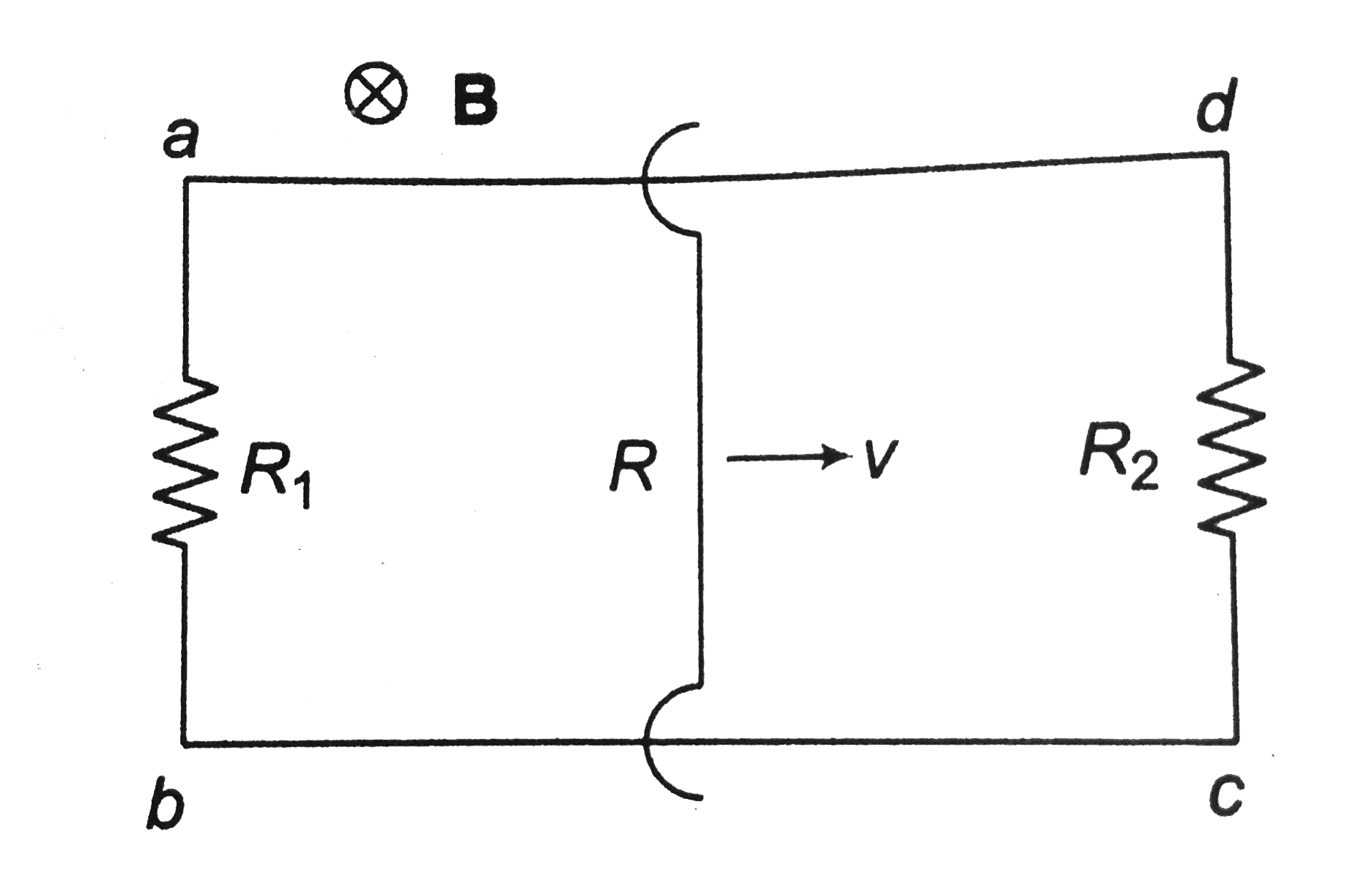 01:20View Solution
01:20View SolutionA metal disc of radius `R = 25 cm` rotates with a constant angular velocity `omega` = `130` rad `s^(-1)` about its axis. Find the potential difference between the center and rim of the disc if
(a) the external magnetic field is absent,
(b) the external uniform megnetic field `B = 5.0`mT directed perpendicular to the disc.08:03View SolutionA thin wire `AC` shaped as a semi-circle of diaameter `d = 20 cm` rotates with a constant angular velocity `omega = 100` rad/s in a unifrom magnetic field of induction `B = 5.0 mT`, with `omega uarr uarr B`. The rotation axis passes through the end `A` of the wire and is perpendicular to the diameter `AC`. Find the value of a line intergal `int E dr` along the wire from point `A` to `C`. Generalize the botained result.
08:12View SolutionA wire loop enclosing as semicircle of radius `R` is located on the boudary of uniform magnetic field `B`. At the moment `t=0`, the loop is set into rotation with a costant angular acceleration `alpha` about an axis `O` coinciding with a line of vector B on the boundary. Find the emf induced in the loop as a function of time. Draw the approximate plot of this function.The arrow in the figure shows the emf direction taken to be positive.
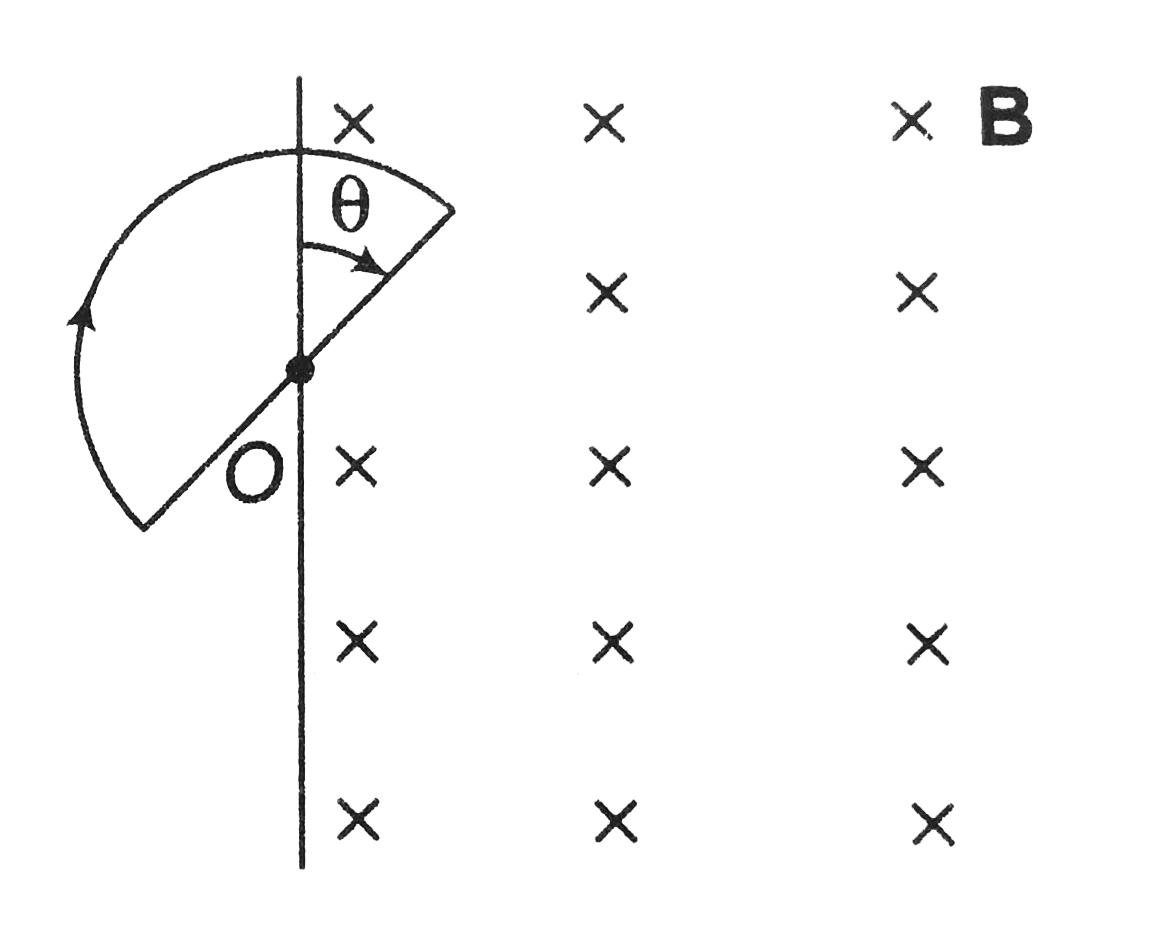 04:22View Solution
04:22View SolutionA long straight wire carrying a current `I` and a `II`- shaped conductor with siding connector are located in the same plane as shown in Fig. The connector of length `l` and resistance `R` sides to the right with a current induced in the loop as a function of separation `r` between the connector and the stragiht wire. The resistance of the `II`-shaped conductor and the self-induced of the loop are assumed to be negligible.
 03:40View Solution
03:40View SolutionA square frame with side a and a long straight wire carrying a current `i` are located in the same plane as m shown in figure. The fram translates to the right with a constant velocity `v`. Find the emf induced in the frame as a function of distance `x`.
 01:47View Solution
01:47View SolutionA metal rod of mass `m` can rotate about a horizontal axis `O`, sliding along a circular conductor of radius `a` (fig). The arrangment is located in a unifrom magnetic field of induction `B` directed perpendicular to the ring plane. The axis and the ring are connected to an emf source to form a circuit of resistance `R`. Neglecting the friction, circuit induction and ring resistance, find the law according to which the source and must very to make the rod rotate with a constant angular velocity `omega`.
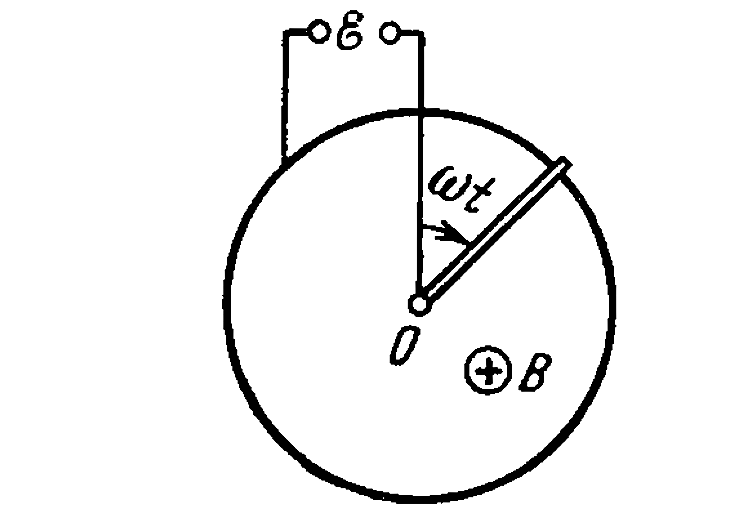 08:02View Solution
08:02View SolutionA copper connector of mass `m` slides down two smooth cooper bars, set at an angle `alpha` to the horizontal due to gravity (Fig). At the top the bars is equal to `l`. The system is located in a unifrom magnetic field of induction `B`, perpendicular to the plane in which the connector slides. The resistances of the bars, the connector and the sliding contacts, as well as the self-inductance of the loop, are assumed to be negligible. Find the steady-state velocity of the connector.
 04:30View Solution
04:30View SolutionThe system differs from the one examined in the foregoing problem (Fig ) by a capacitor of capacitance `C` replacing the resistance `R`. Find the accelearation of the connector.
 04:01View Solution
04:01View SolutionA wire shaped as a semi-circle of radius a rotates about sn sxis `OO'` with an angular velocity `omega` in a unifrom magnetic field of induction `B'` (Fig). The rotation axis is perpendicular to the field direction. The total resistance of the circuit is equal to `R`. NEglecting the magnetic field of the induced current, find the meand amount of thermal power being generated in the loop fueing a rotation period.
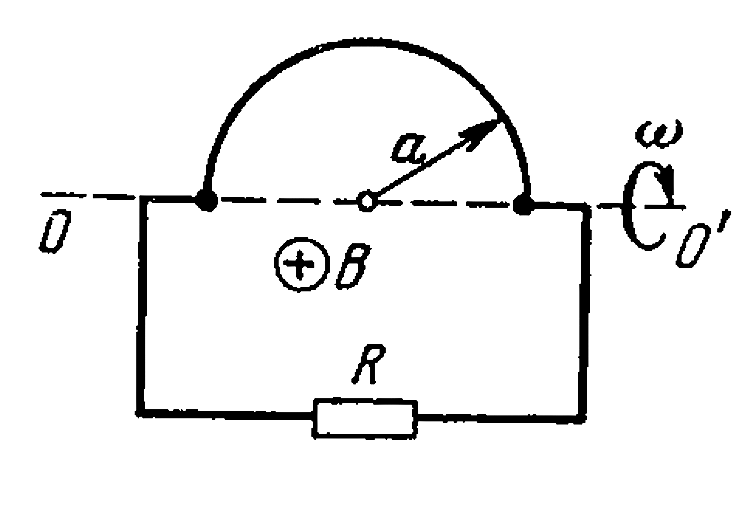 05:51View Solution
05:51View SolutionA small coll is intorduced between the poles of an electromagnent so that its axis coincides with the magnetic field direction. The cross sectional ara of the coil is equal to `S = 30 mm^(2)`, the its diameter a balistic galvanometer connected to the coil indicates a charge `q = 4.5 muC` flowing through it. Find the magnetic induction magnitude between the poles provided the total resistance of the electric circuit equals `R = 40 Omega`
03:32View SolutionA square wire frame with side `a` and a straight conductor carrying constant current `I` are located in the same plane (Fig). The inductance and the resitance of the frame are equal to `L` and `R` respectively. The frame was turned throgh `180^(@)` about the axis `OO'`separated fromt the current carrying conductor by a distance `b`. FInd the electric charge having flown through the frame.
 08:41View Solution
08:41View SolutionA long straight wire carries a current `I_(0)`. At distances `a` and `b` from it there are two other wires, parallel to the former one, which are interconnected by a resistance `R` (Fig). A connector slides without friction along the wires with a constant velocity `v`. Assuming the resistances of the wires, the conductor, the sliding contacts, and the self-inductance of the frame to be negligable, find:
(a) the magnitude and the direction of the current induced in the connector,
(b) the force required to maintain the connector's velocity constant.
 06:26View Solution
06:26View SolutionA conductor rod `AB` of mass `m` slides without friction over two long conducting rails separated by a distance (Fig) At the left end the raidls are interconnected by a resistance `R`. The system is located in a unifrom magnetic fileld perpendicular to the plane of the loop. At the moment `t = 0` the rod `AB` starts moving to the right with an initial velocity `v_(0)`. Neglecting the resistances of the rails and the rod `AB`, as wellas the self -indcuctance, find:
(a) the distance covered by the rod until it comes to a standsill,
(b) the amount of heat generated in the resitance `R` during this process.
 05:03View Solution
05:03View SolutionA connector `AB` can slide without frictiion along a `II`-shaped conductor located in a horizontal plane (Fig). The connector has a length `l`, mass `m` and resistance `R`. The whole system is located in a unifrom magnetic field of induction `B` directed vertically. At the moment `t = 0` a constant horizontal force `F` starts acting on the connector shifting it translationwise to the right. Find how th e velocity o fhte connector varies with time `t`. The inductance of the loop and the resistance of the II-shaped conductor conductor are assumed to be negligible
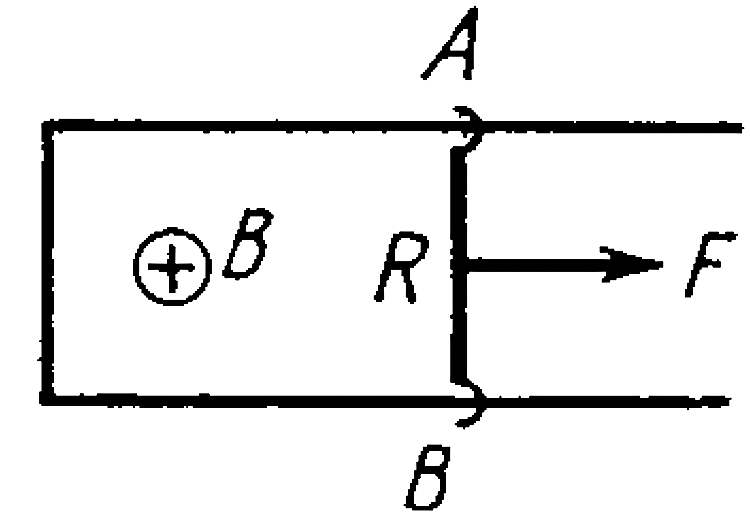 04:22View Solution
04:22View SolutionFig. illustrates plane figures made of thin conductors which are located in a uniform magnetic field directed away from a reader beyond the plane of the drawing. The magnetic induction starts diminshing. Find how the currents induced in these loops are directed.
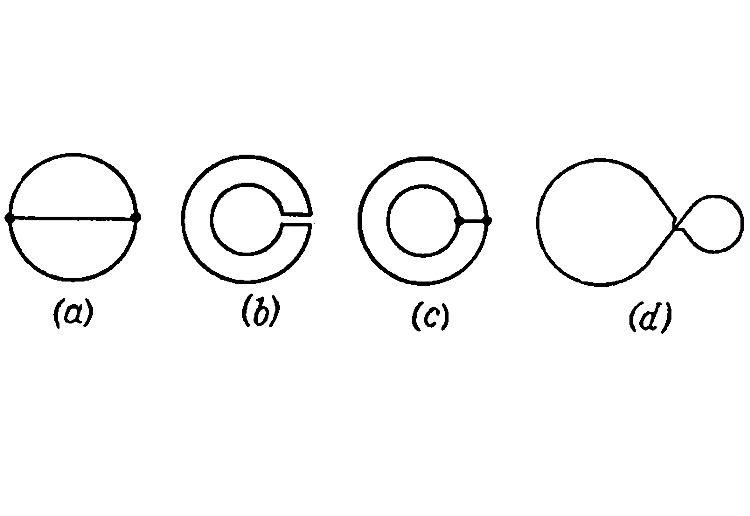 03:58View Solution
03:58View SolutionA plane loop is shaped as two squares (Fig) and placed in a uniform magnetic field at right angle to the loop's plane. The magnetic induction varies with time as `B =B_(0) sin (omega)t, where B_(0) = 10 mT and (omega) = 100 rads^(-1)`. The wires do not touch at point A. If resistance per unit length of the loop is `50 m(Omega)// m`, then amplitude of current induced in the loop is
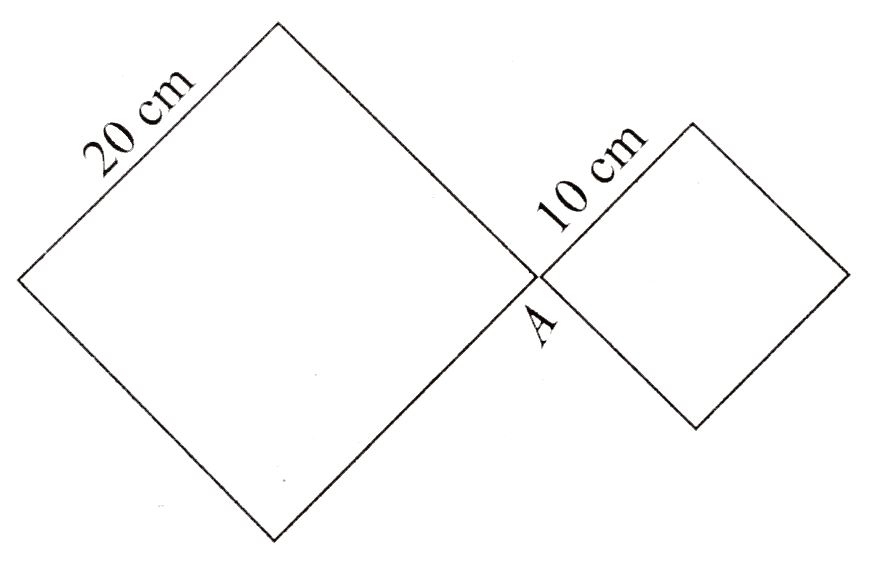 05:53View Solution
05:53View SolutionA plane loop is shaped as two squares (Fig) and placed in a uniform magnetic field at right angle to the loop's plane. The magnetic induction varies with time as `B =B_(0) sin (omega)t, where B_(0) = 10 mT and (omega) = 100 rads^(-1)`. The wires do not touch at point A. If resistance per unit length of the loop is `50 m(Omega)// m`, then amplitude of current induced in the loop is
 05:53View Solution
05:53View SolutionA `pi` shaped metal frame is located in a uniform magnetic field perpendicular to the plane of the conductor and varying with time at the rate `(dB//dt)=0.I0T//sec` . A conducting connector starts moving with an acceleration `a=I0cm//sec^(2)` along the parallel bars of the frame. The lenght o0f the connector is equal to `l=20cm` . Find the emf induced in the loop `t=2sec` after the beginnig of the motion, if at the moment `t=0` the loop area and the magnetic induction are equal to zero. The inductance of the loop is to be neglected.
06:54View SolutionIn a long staright solenoid with cross-sectional radius `a` and number of turns per unit length `n` a current varies with a constant velocity` dotI A//s`. Find the magntidue of the eddy current field strength as a function of the distance `r` from the solenoid axis. Draw the appoximate plot of this function.
03:58View SolutionA long straight solenoid of cross-sectional diameter `d = 5 cm` and with `n = 20` turns per one cm of its length has a round turn of copper wire of cross-sectional area `S = 1.0 mm^(2)` tightly put on its winding. Find the current flowing in the turn if the current in the solenoid winding is increased with a constant velocity `dotI = 100 A//s`. The inductance of the turn is to be neglected.
03:48View SolutionA long solenoid of cross-sectional radius `a` has a thin insulates wiere ring tightly put on its winding, one half of the ring has the resistance `eta` times that of the other half. The magneticv induction produced by the solenoid varies with the time as `B = bt`, where `b` is a constant. Find the magnitude of the electric field strength in the ring.
09:03View SolutionA thin non-conducting ring of mass `m` carrying a charge `q` can freely rotate about its axis. At the initial moment the ring was at rest and no magnetic field was present. Then a practically unifrom magnetic field was switched on, which was perpendicular to the planeof the ring and increased with time according to a certain law `B (t)`, Find the angluar velocity `omega` of the ring as a function of the induction `B(t)`.
03:21View SolutionA thin wire ring of radius a and resitance `r` is located inside a long solenoid is equal to `l`, its cross-sectional radius , to `b`. At a certain moment the solenoid was connected to a source of a constant voltage `V`. The total resistance of the circuit is equal to `R`. Assuming the the radial force acting per unit length of the ring.
07:37View SolutionA magentic flux through a statinary loop with a resistance `R` varies during the tiem interval `tau` as `Phi = at (tau - t)`. Find the amount of heat generated in the loop during that time. The inductance of the loop is to be neglected.
03:43View SolutionIn the middle of a long solenoid there is a coaxial ring of square cross-seciton, made of conducting materaial with respectivity are equal to `h` its inside and outside radii are equal to `a` and `b` respectively. Find the current induced in the ring if the magnetic induction produced by the solenoid varies with time as `B = beta t`, where `beta t`, where `beta` is constant. THe inductance of the ring is to be neglected.
04:04View SolutionHow many meters of a thin wire are required to manufacture a solenoid of length `l_(0) = 100 cm` and inductance `L = 1.0 mH` if the solnoid's cross -sectional diameter is condiserably less than its length ?
03:21View SolutionFind the inductance of a solenoid of length `l` whose winding is made of copper wire of mass `m`. The winding resistance is equal to `R`. The solenoid diameter is considerably less than its length.
04:07View SolutionA coil of inductance `L = 300 mH` and resitance `R = 140 m Omega` is connected to a constant voltage source. How soon will the coil current reach `eta = 50 %` of the steady-state value ?
04:23View SolutionCalculate the time constant `tau` of a straight solenoid of length `l = 1.0 m` having a single-layer winding of copper wire whose total mass is equal to `m = 1.0 kg`. The cross-sectional diameter of the solenoid is assumed to be considerably less than its length.
03:24View SolutionFind the inductance of a unit length of a cable consisting of two thin-walled coaxial metallic cylinders if the radius of the outside cylinder is `eta = 3.6` times that of the inside one. The permeabitity of a medium between the cylinders is assumed to be equal to unity.
View SolutionCalculate the inducatance of a doughunt solenoid whose inside radius is equal to `b` and cross-section has the form of a square with side `a`. The solenoid winding consists of `N` turns. The space inside the solenoid is filled up with unifrom paramagnetic having permeability `mu`.
04:02View SolutionCalculate the inuctance of a unit length of a double tape line (Fig) if the tapes are separated by a distance `h` which is considerabley less than their width `b`, namely, `b//h = 50`.
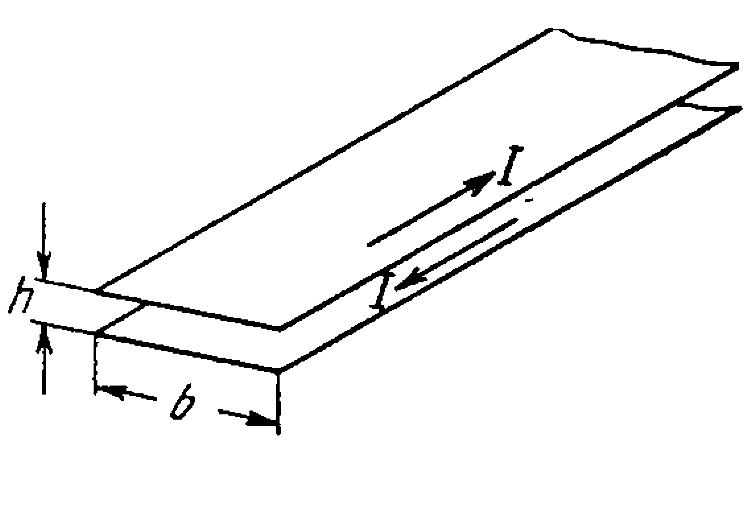 03:38View Solution
03:38View SolutionFind the inductane of a unit length of a double line if the radius of each wire is `eta` times less than the distance between the axes of the wires. The field inside the wires is to be neglected, the permeability is assumed to be equal to unity throughout, and `eta gt gt 1`.
04:47View SolutionA supercondutig round ring of radius `a` and inductance `L` was located in a unifrom magnetic fied of induction `B`. The ring plane was parallel to the vector `B`, and the current in the ring was equal to zero. Them the ring was turned through `90^(@)` so that its plane became perpendicular to the feild. FInd:
(a) the current induced in the ring after the turn,
(b) the work perfromed during the turn.04:36View SolutionA Current `I_(0) = 1.9 A` flows in a long closed solenoid. The wire it is wound of is a superconducting state. Find the current flowing in the solenoid when the length of the solenoid is increased by `eta = 5 %`.
03:53View SolutionA ring radius `a = 50 mm` made of thin wire of radius `b = 1.0 mm` was located in a unifrom magnetic field with induction `B = 0.50 mT` so that the ring place was perpenficular to the vector `B`. Then the ring was cooled down to superconducting state, and the magnetic field was swichted off. Find the ring current after that. Note that the inductiance of a thin ring along which the surface current flows is equal to `L = mu_(0)a (In (8a)/(b) - 2)`.
03:26View SolutionA closed circuit consits of a source of constant and `E` and a choke coil of inductance `L` connected in series. The active resistance of the whole circuit is equal to `R`. At the moment `t = 0` the choke coil inductance was decreased abrupty `eta` times. FInd the current in the circuit as a function of time `t`.
04:56View SolutionFind the time dependence of the current flowing through the inductance `L` of the circuit shown in Fig after the swich `Sw` is shorted at the moment `t = 0`.
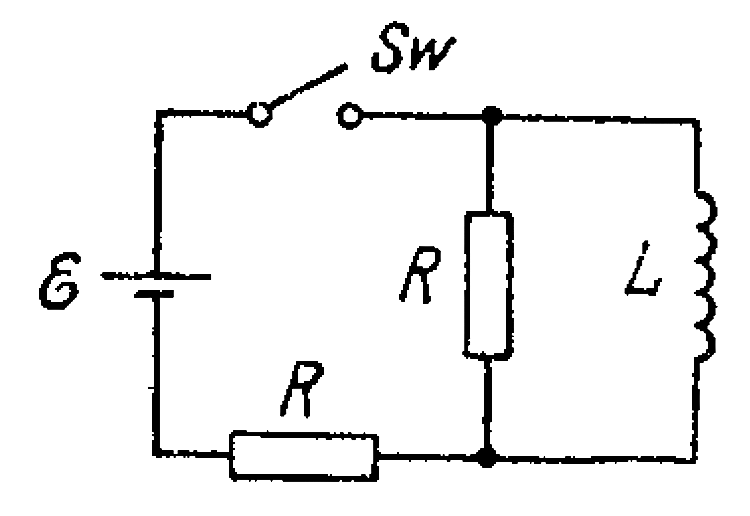 04:13View Solution
04:13View SolutionIn the circuit shown in Fig. `emf E` , a resistance `R`, and coil inductances `L_(1)` and `L_(2)` are known. The internal resistance of the source and the coil resistances are neglible. Find the steady-state currents in the coils after the swich `Sw` was shorted.
 03:43View Solution
03:43View SolutionCalculate the mutual inductance of a long straight wire and a rectangular frame with sides `a` and `b`. The frame and the wire lie in the same plan, with the side `b` being closent to the wire, separated by a distance `l` from it and oriented parallel to it.
03:04View SolutionDetermine the mutual inductance of a doughnut coil and an infinite straight wire passing along its axis. The coil has recatangular cross-section, its inside radius is equal to `a` and the outside one, to `b`. The length of the doughtnut's cross-sectinla side parallel to the wire is equal to `h`. The coil has `N` turns. The system is located in a unifrom magnetic with permeability `mu`.
02:34View SolutionTwo thin concentric wires shpaed as circles with radii `a` and `b` lie in the same plane. Allowing for `a lt lt b`, find:
(a) their mutual inductane,
(b) the magnetic flux through the surface enclosed by the outside wire, when the inside wire carries a current `I`.02:40View SolutionA small cylindrical magnet `M` (Fig) is placed in the centre of a thin coil of radius a consisting of `N` turns. The coil in connected to a ballistic galvanometer. The active resistance of the whole circuit is equal to `R`. Find the magnetic moment of the magnet if its removel from the coil results in a charge `q` flowing through the galvanometer.
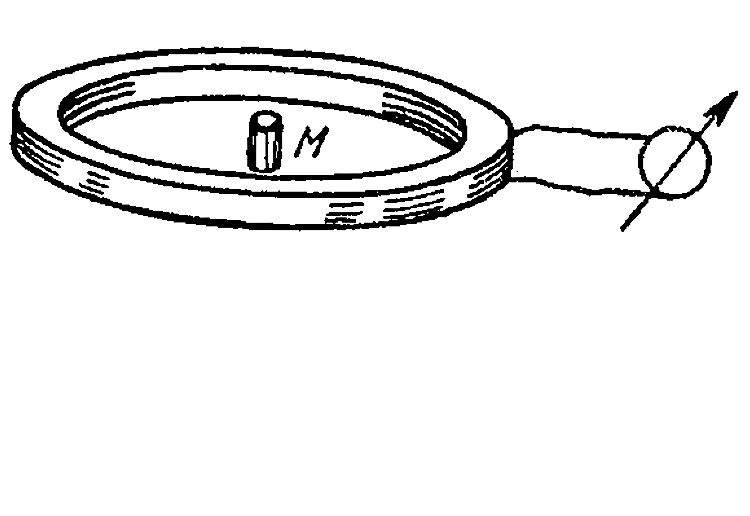 03:48View Solution
03:48View SolutionFind the appoximate formula expressing the mutual inductance of two thin coaxial loops of the same radius `a` if their centres are separated by a distance `l`, with `l gt gt a`
02:26View SolutionThere are two stationary loops with mutual inductance `L_(12)`. The current is one of the loops starts to be varied as `I_(1) = alpha t` where `alpha` is a current, `t` is time. Find the time dependence `I_(2) (t)` of the current in the other loop whose inductance is `L_(2)` and resistance `R`.
03:10View SolutionA coil of inductance `L = 2.0 mu H` and resitance `R = 1.0 Omega` is connected to a source of constant `emf E = 3.0 V`. A resistance `R_(s) = 2.0 Omega` is connected in parallel with the coil. Find the amount of heat generated in the coil after the swich `Sw` is disconnecied. The internal resistance of the source is negligible.
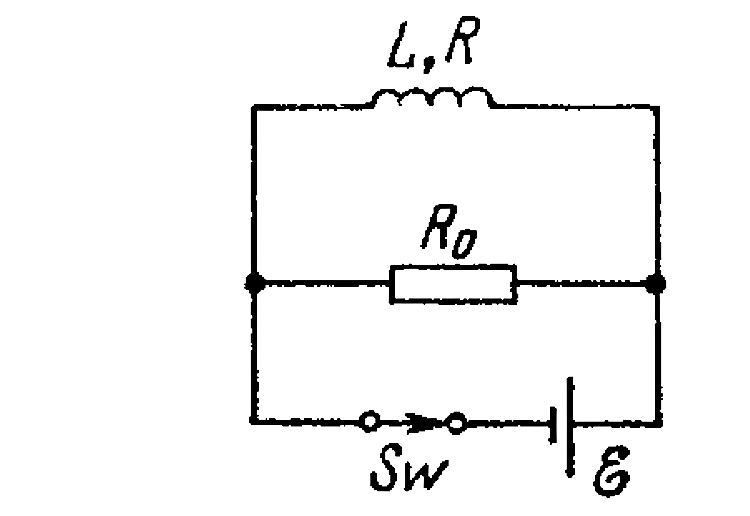 04:03View Solution
04:03View SolutionAn iron tor suports `N = 500` turns. Find the magnetic field energy if a current `I = 2.0 A` preoduces a magnetic flux across the tore's cross-section equal to `Phi = 1.0 mWb`.
02:08View SolutionAn iron core shaped as a doughnut with round cross-section of radius `a = 3.0 cm` carreis a winding of `N = 1000` turns through which a current `I = 1.0 A` flows. The mean radius of the doughnut is `b = 32 cm`. Using the polt in Fig. Find the magnetic energy strored up in the core. A field strength `H` is suposed to be the same throughout the cross-section and equal to its magnitude in the centre of the cross-section.
03:04View SolutionA thin ring made of magnetic has a mean diameter `d = 30 cm` and supports a winding of `N = 800` turns. The cross-sectional area of the ring is equal to `S = 5.0 cm^(2)`. The ring has a cross-cut of width `b = 2.0 mm`. When the winding carries a certain current, the permeability of the magnectic equals `mu = 1400`. Neglectign the disipation of magnetic flux at the gap edges, find:
(a) the ratio of magnetic energies in the gap and in the magnetic,
the inductance of the system, do it two ways: using the flux and using the energy of the field.08:37View SolutionA long cylinder of radius `a` carrying a unifrom surface charge rotates about its axis with an anglur velocity `omega`. Find the magnetic field energy per unit length of the cylinder if the linear charge density equals `lambda` and `mu = 1`.
05:00View SolutionAt what magnetic of the electric field srength in vacumm the volume energy density of this field is the same as that of the magnetic field with induction `B = 1.0 T` (also in vacumm).
02:15View SolutionA thin uniformly charged ring of radius `a = 10 cm` rotates about its axsi with an angluaar velocity `omega = 100 rad//s`. Find the ratio of volume energy densities of magnetic and electric fields on the axis of the ring at a point removed from its centre by a distance `l = a`
03:29View SolutionUsing the expression for volume density of magnetic eneregy, demonstare that the amount of work contributed to magnetization of a unit volume of para or diamagentic, is equal to `A = -JB//2`.
02:36View SolutionTwo indentical coils, each of inductance `L`, are interconnected (a) in series, (b) in parallel. Assuminng the mutual insducane of the coils to be negliglible, find the inductance fo the system in both cases.
03:12View SolutionTwo solenoids of equal length and almost equal cross-sectional area are fully inserted into one another Find their mutual inductances are equal to `L_(1)` and `L_(2)`.
02:21View SolutionDemonstarate that the magnetic energy of interaction of two current-carrying loops located in vacumm can be represented as `W_(ia) = (1/mu_(0)) int B_(1) B_(2) dV`, where `B_(1)` and `B_(2)` are the magnetic inductions within a volume element `dV`, produced indiviually by the currents of the first and the secound loop respectively.
03:10View SolutionFind the interaction energy of two loops carrying currents `I_(1)` and `I_(2)` if both loops are shaped as circles of radii `a` and `b`, with `a lt lt b`. The loops centres are located at the same point and their planes from an angle `theta` between them.
02:35View SolutionThe space between two concentric metallic spheres is filled up with a unifrom poorly conducting medium of resistivity `rho` and permittivity `epsilon`. At what moment `t = 0` the inside sphere obtains a certain charge. Find:
(a) the relation between the vectros of displacement current density and conduction current density at an arbitarry point of the medium at the same moment of time,
(b) the displacement current across an arbitrary closed surface wholly located in the medium and enclosing the internal sphere, if at the given moment of time the charge of that sphere is equal to `q`.05:03View SolutionA parallel plate capcitor is formed by two discs with a unifrom poorly conducting medium between them. The capacitor was initally charged and then disconnected form a voltage source. Neglecting the edge effects, show that there is no magnetic field between capcitor plates.
02:28View SolutionA parallel plate air condenser whose each plate has an area `S = 100 cm^(2)` is connected in series to an ac circuit. Find the electric field strength amplitude in the capacitor if the sinusolidal current amplitude in lead wires is equal to `I_(m) = 1.0 mA` and the current frequency equals `omega = 1.6 . 10^(7)S^(-1)`.
03:04View SolutionThe space between the electrodes of a parallel-plate capacitor is filled with a uniform poorly conducting medium of conductivity `sigma` and permittivity `epsilon`. The capacitor plates shaped as round discs are separted by a distance `d`. Neglecting the edge effects, find the magnetic field strength between the plates at a distance `r` from their axis if an ac voltage `V = V_(m) cos omega t` is applied to the capacitor.
View SolutionA long straight solenoid has `n` turns per unit length. An alternating current `I = I_(m) sin omega t` flows throught it. Find the displacement current density as a function of the distnace `r` from the solenoid equals `R`.
03:18View SolutionA point charge `q` moves with a non-relatives velocity v = const. Find the displacement current density `dotd` at a point location at a distance `r` from the charges on a straight line
(a) coinciding with the charge path,
(b) perpendicualr to the path and passing through the charge.03:02View SolutionA thin wire ring of radius `a` carrying a charge `q` approcahes the observation point `P` so that its centre moves rectilinearly with a constant velocity `v`. The plane of the ring remians perpendicular to the motion direction. At what distance `x_(m)` from the point `P` will the ring be located at the moment when the displacement current density at the point `P` becomes maximum? What is the magnitude of this maximum density ?
03:31View SolutionA point charge `q` moves with a non-relativestic velocity v = const. Applying the theorem for the circulation of the vector `H` around the dotted circle shown in Fig, `H` at the point `A` as a function of a radius vector `r` and velocity `v` of the charge.
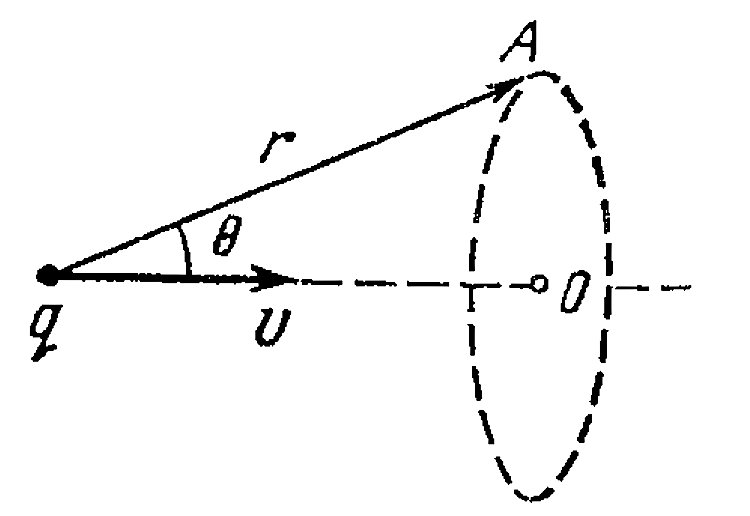 04:28View Solution
04:28View SolutionUsing Maxwell's equacations. Show that
(a) a time dependent magnetic field cannot exist without an electric field,
(b) a unifrom electric field cannot exist in the presence of a time-dependence magnetic field,
(c) inside an empty cavity a unifrom electric (or magnetic ) field can be time-dependent.View SolutionDemonstrate that the law of electric charge conservation, i.e., `grad. J = -del rho//del t`, follows from Maxwell's equactions.
View SolutionDemonstrate that Maxwell's equations `grad xx E = -del B //del t` and `grad.B = 0` are compatible, i.e., the first one does not contradict the secound one.
View SolutionIn a certain region of the inertial reference frame there is magnetic field with induction `B` rotating with angluar velocity `omega`. Find `grad xx E` in this region as a function of vectors `omega` and `B`
View SolutionIn the interial reference frame `K` there is a unifrom magentic field the induction `B`. Find the electric feidl strength in the frame `K'` which moves relative to the frame `K` with a non-relatistic veclocity `v`, with `v _|_ B`. To solve this problem, consider the forces acting an an imaginary charge in the frame `K'` is equal to zero.
02:34View SolutionA large plate of non-ferromagnetic material moves with a constant velocity `v = 90 cm//s` in a unifrom magnetic field with induction `B = 50 mT` as shown in Fig. Find the surface density of electric charges appearing on the plate as a result of its motion.
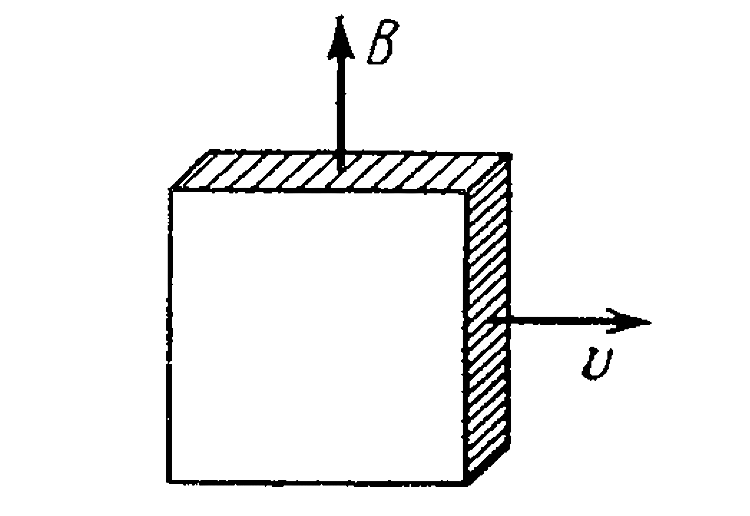 02:58View Solution
02:58View SolutionA long solid aluminum cylinder of radius `a = 5.0 cm` rotates about its axis in unidrom magnetic field with induction `B = 10 mT`. The angluar velocity of rotation equlas `omega = 45 rad//s` with `omega uarr uarr B` Neglecting the magnetic field of appearing chagres, find their spcae and surfaface densities.
View SolutionA non-relativistic point charge `q` moves with a constant velocity `v`. Using the field transformation formula. Find the magnetic induction `B` produced by this charge at the point whose position relative to the charge is determind by the radius vector `r`.
View SolutionUsing Eqs. Demonstrate that if in the intertial reference frame `K` there is only electric or only magnetic field. In any other interial frame `K'` both electric and magnetic fiedls will coxist simutaneously, with `E' _|_ B'`.
View SolutionIn an interial reference frame `K` there is only magnetic field with induction `B = b (yl -x)//(x^(2) + y^(2))`, where `b` is a constane, `i` and `j` are the unit vectors of the `x` and `y` axes. Find the elecric field strength `E'` in the frame `K'` moving relative to the frame `K` with a constatn non-relative velocity `v = vk, k` is the unit vector of the z-axis. The `z'` axis is assumed to coincule with the `z` axis. What is the shape of the field `E'` ?
02:43View SolutionIn an interial reference from `K` there is only electric field of strength `E = a (xl + y)//x^(2) + y^(2))`, where `a` is a constant, `i` find `j` are unit vectors of the `x` and `y` axes. Find the magtnetic induction `B'` in the frame `K'` moving relative to the freame `K` with a consant non-relativistic velocity `v = vkl k` is the unit vector of the z-axis. The `z'` axis is assumed to coincule with the z-axis. What is the shape of the magnetic induction `B'` ?
View SolutionDemostrate that the transformation forumulas (3.6h) fllow from the formulas `(3.6i)` at `v lt lt c`.
View SolutionIn an inertial reference frame `K` there is only a unifrom electric field `E = 8 kV//m` in strength. Find the modulus and direction
(a) of the vector `E'` (b) of the vector `B'` in the interial refrernce frame `K'` moving with a constant velocity `v` relative to the frame `K` at an angle `alpha = 45^(@)` to the vector `E`. The velocity of the frame `K'` is equla to a`beta = 0.60` fraction of the velocity of light.View SolutionSolve a problme differing from the forgoing one by a magnetic field with induction `B = 0.8 T` replacing the electric field.
View SolutionElectromagnetic field has two invariant quatities. Using the transformation formulas `(3.6 i)` demonstrate that these quanties are
(a) `EB`, (b) `E^(2) - c^(2) B^(2)`.View SolutionIn an interial reference frame `K` there are two uniform mutulaly perpendicular fields, an electric field of strength `E = 40 kV//m` and a magnetic fleid induction `B = 0.20 mT`. Find the electric strength `E'` (or the magnetic induction `B'`) in the reference frame `K'` where only one field, electric or magnetic, is observed.
View SolutionA point charge `q` moves unifromly and rectilnearly with a relativistic with a relativistic velocity of light `(beta = v//c)`. Find the electric field strength `E` produced by the charge at the point whose radius vector relatives to the charge is equal to `r` and forms an angle `theta` with its velocity vector.
View Solution
Electromagnetic Induction questions and complete solutions for chapter ELECTRODYNAMICS of IE IRODOV PHYSICS (HINGLISH) of Class 12
